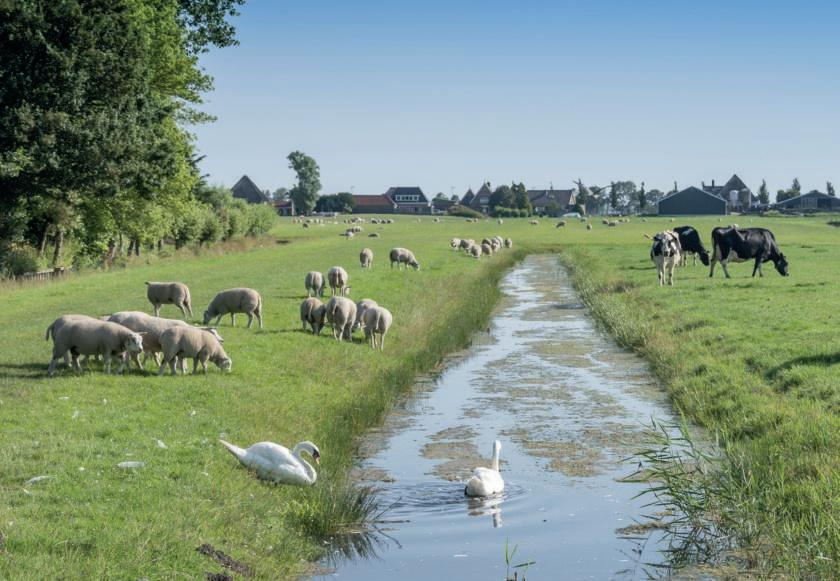
5 minute read
National and international cooperation
Together we are stronger and we know more. That’s why it’s important that various organisations cooperate to monitor animal health. Within the Netherlands but also further afield. An extensive network has developed over the years, which continues to grow.
Animal health monitoring in the Netherlands is an initiative of the government and livestock farming sector; the parties involved jointly determine the form it takes. This cooperation between private and public parties is one of the success factors of the monitoring process. We exchange a great deal of knowledge with other parties (supplementary knowledge and for example alternative laboratory technology) for absolute maximum benefits. Human and veterinary parties work together under the principle of ‘One Health’. This allows us to take timely measures in the event of zoonoses, pathogens which are transferable from animals to people.
Joke van der Giessen
International cooperation
Although we do our very best here, animal diseases do not stop at the national borders. That’s why in its research and knowledge exchange activities, GD cooperates with a broad and steadily growing international network of researchers and laboratories. Thanks to this exchange, monitoring information can be placed in a broader framework, thus improving the chances of early detection of new disorders and giving insight into the best possible response. Joke van der Giessen and Marcel Spierenburg (who work for parties with which GD cooperates) can tell us more about the importance of international cooperation.
Joke van der Giessen
veterinary microbiologist and senior zoonoses researcher (RIVM) and chair of the Signalling Forum for Zoonoses
“It is important to collaborate closely, from detection to combating zoonoses”
“The Centre for Infectious Disease Control of the Dutch National Institute for Public Health and the Environment (RIVM) coordinates the signalling to response including zoonoses of infectious diseases in the Netherlands. These include the compulsory notification diseases, but also non-compulsory notification diseases such as newly emerging infectious diseases. The RIVM is responsible for international notifications to the European Centre for Disease Prevention and Control (ECDC) and the World Health Organization (WHO). When it comes to zoonoses, we work closely with other organisations, as the combating of animal disease is not a task of RIVM. For farm animals, we collaborate frequently with GD.
As part of the zoonoses structure and in the light of the ‘One Health’ principle, the human and veterinary sectors meet monthly in the Signalling Forum for Zoonoses (SO-Z). This includes experts from the various GD sectors, but also experts from WBVR, the Dutch Wildlife Health Centre (DWHC), the Faculty of Veterinary Medicine and the NVWA, including the Vector Monitoring Centre (CMV). There we discuss the signals received from animal health monitoring; relevant signals are reported monthly. Urgent signals can be transferred to the following stage of the zoonoses structure.


Understanding each other’s language
In each form of collaboration, it is extremely important that you know each other, develop a good relationship, understand each other’s language and can trust each other. It is also essential to reach good agreements on how to respond to signals and how to share them in a safe manner.
Challenge for the future
The COVID-19 pandemic has shown what an enormous impact a zoonosis can have on society. But how do we prevent this in the future? In the Netherlands, many people and animals cohabit in a small space, which makes effective infrastructure and good collaboration between the domains extremely important. Food production and animal husbandry are top notch in this country. The challenge lies in rendering this more sustainable in a way that animal health, public health and animal welfare remain guaranteed.”
Marcel Spierenburg
coordinating veterinary inspector at the NVWA Incident and Crisis Centre (NVIC), legal adviser and KNMvD recognised specialist in veterinary public health
“In case of an outbreak, we can react very quickly”
“Despite all the great efforts, diseases such as avian influenza (AI) cannot always be kept out. AI is widespread among wild water birds in Europe. Furthermore, we are detecting a different serotype of AI almost every year, introduced by birds migrating from Asia. From autumn 2021 onwards, we have been dealingwith an extremely virulent variant (HPAI H5N1), which causes outbreaks at all kinds of poultry farms. The NVWA, and specifically the Incident and Crisis Centre (NVIC) is responsible for timely detection of diseases and suspicion of animal diseases that based on European legislation, may be compulsory notification or even compulsory treatment diseases. The NVIC team coordinates the processing of suspicious cases and combating of animal diseases and zoonoses.
Marcel Spierenburg
The initial notification is generally made by the farmer or their veterinarian. AI can present with various clinical signs, depending on the type of poultry. Upon necropsy, pinpoint haemorrhaging in the heart and the proventriculus are signs of AI. We collect all the information and are in contact with the farmer, veterinarians and GD. When AI is suspected, we always send a team that includes the farmer’s veterinarian and a GD veterinarian. They take samples and immediately lock down the farm. The samples are sent directly with our own courier to the national reference laboratory in Lelystad, at WBVR, where PCR tests are carried out. The results are available within 6 to 8 hours, and initially sent to the NVWA. We then immediately inform the farmer and veterinarians. In the event of an outbreak, we also inform the Minister of Agriculture, Nature and Food Quality, and we initiate the culling process. We also call the local government, the RIVM and the Area Health Authority (GGD).
The quicker, the better
There is an effective structure in place in the Netherlands, from monitoring to control. It is a well-oiled machine, which is why we can react quickly. We collaborate effectively, and GD can make excellent analyses on the risks of outbreaks, based on the monitoring data. There are also plenty of options in terms of diagnostics. The quicker diseases are detected, the better.”






